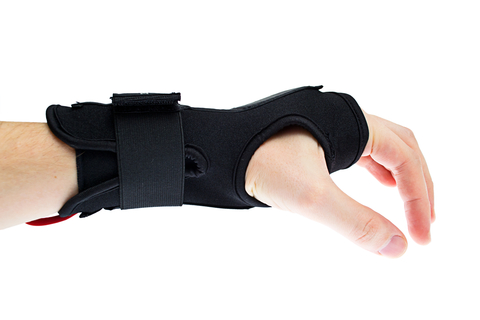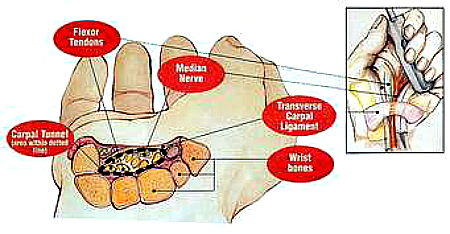What is carpal tunnel syndrome?
Pain and numbness in the hand and fingers is a common complaint and can have many causes. First, let’s look at some anatomy. As can be seen in Fig 1, there are multiple tendons and a major nerve in an enclosed space known as the carpal tunnel. By far, the most common cause of numbness occurs when this particular nerve, known as the median nerve, experiencing some degree of pressure or compression. Nerves poorly tolerate compression; even a slight amount can block electrical conduction. This block in conduction is what causes the numbness (Fig 2). Compression of the median nerve at the wrist, known as Carpal Tunnel Syndrome (CTS), is the most common cause of numbness in the fingers.

Fig 1 
Fig 2
How does carpal tunnel syndrome present?
Patients note pain at the site of compression, and “downstream” to the site, there will be numbness to where that nerve supplies sensation. Symptoms are in the anatomical distribution of the median nerve, typically the thumb, index and middle fingers. Patients may notice that symptoms are worse at night, often interfering with sleep (frequent awakenings are a primary reason patients seek medical care). Clumsiness or loss of dexterity with daily activities are also common. Severe, long term compression will eventually damage the muscles (motor function) supplied by the median nerve, resulting in muscle wasting, known as atrophy.
Am I doing something to cause carpal tunnel syndrome?
Symptoms can be caused by repetitive motions, (eg typing, Fig 3), and certain activities which put undue pressure and/or vibration to the nerve at the wrist (eg hammering). Certain athletic events, like cycling, can also put pressure on the nerve. Conditions which decrease the available space for the nerve, such as fluid shifts in pregnancy can cause carpal tunnel syndrome. Other factors associated with CTS include hypothyroidism, gout, and smoking.

How is carpal tunnel syndrome diagnosed?
In most cases, the diagnosis of CTS can be made by taking a careful history and knowing what to look for on physical exam. Often, to confirm the diagnosis, a nerve conduction study is also done. In this test, little (acupuncture sized) needles are inserted along the course of the nerve to test the speed of conduction (because the needles are so small, not as bad as it sounds)
How is carpal tunnel syndrome treated?
First line treatment for CTS should include night splints (Fig 4), NSAIDS, and avoiding aggravating activities. Sometimes a cortisone injection into the carpal tunnel region can decrease inflammation and improve symptoms.

If conservative treatment fails, treatment is to surgical, namely incising the ligament overlying the carpal tunnel to release pressure on the nerve. Both traditional and endoscopic approaches are used and can be performed under local anesthesia on an outpatient basis. Long term results for both show a low rate of continued symptoms at 1+ years at 2% in moderate and 20% in severe CTS.
Got a question about this topic? Click here
For more information about this website, click here
References
Orthopaedic Knowledge Update (OKU) 11, Published by the American Board of Orthopaedic Surgeons, 2014, pg 433-446

